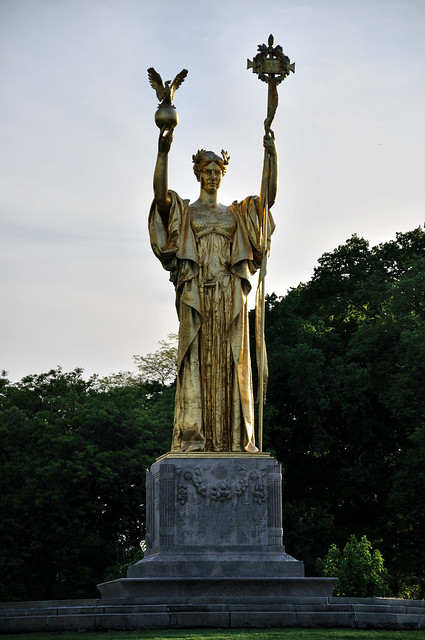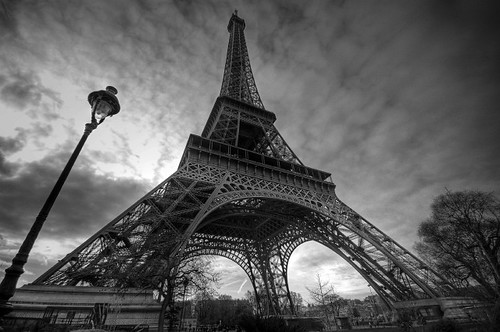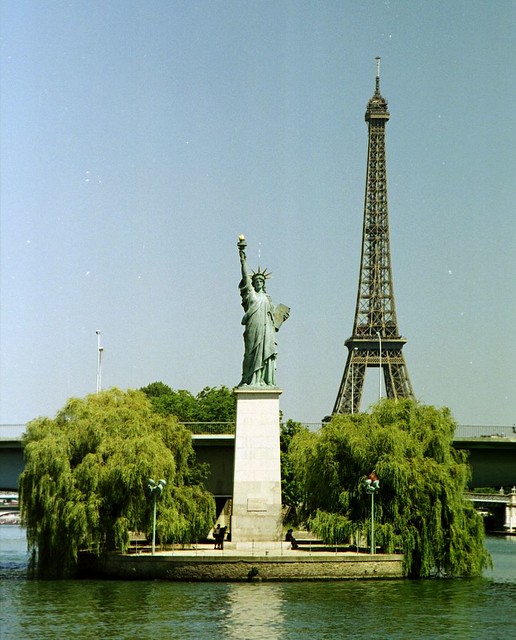Photo courtesy of Carolina Ödman's Flickr page - Eiffel tower: https://www.flickr.com/photos/carolune/2210662414
Creative Commons License: https://creativecommons.org/licenses/by-sa/2.0/
Much like with the Guardian Liberty Voice, I had not actually written or gotten an article published for the new Take Off/Set Sail site in over a month. I felt bad about it, but it has been kind of a chaotic and busy time in my life these last few weeks.
However, I wanted to contribute, and finally did earlier this week. This article was published this past Tuesday, on the 25th of June. It focuses on one man's role in the creation of two of the most famous, really even iconic, landmarks in the modern world.
Please click the link below to take a look:
Gustave Eiffel’s Iconic Ironwork
Last week marked the 130th anniversary of the arrival of the Statue of Liberty to American shores. This was a gift from France to the United States, and was meant as a token of friendship between the two countries.
The Statue of Liberty has stood watch at the entrance to New York Harbor for well over a century, and was one of the iconic landmarks that incoming immigrants would see, knowing they had arrived to America, and a chance at a new life. For many decades, it dominated, being the tallest structure around.
That is no longer the case, in this age of towering skyscrapers. However, the statue is actually quite large, and needed some solid interior to support it and keep it standing. Ironically, the man who designed the iron support system inside of the State of Liberty is very famous for another iconic landmark back in the old continent.
Of course, I am referring to the Eiffel Tower, which has stood for almost as long as the Statue of Liberty has, and which was built in the city of Paris, the same city where the Statue of Liberty was first constructed.
I remember the first time that I visited the Eiffel Tower. I was just a little boy from a Franco-American family, and my parents sent my brother and me to France for the summer, where we had lived just a few years before. All I could think about was how cool it was going to be to visit the Eiffel Tower. When we got to France, the day finally came when we visited it, and I was super excited! It felt like the trip was taking forever, but when the Parisian Metro doors opened, I jolted out of my seat and ran up the escalator before anyone else could cut in front of me. I made it outside, turned, and there she was!
The Eiffel Tower, one of the most famous landmarks in all the world, was right in front of me! Yet, it was different than I thought it would be. First of all, it had netting hanging over the sides, because it was receiving a fresh coat of paint, which happens every seven years. Which brings me to the next thing that I found surprising, that it was painted in a strange brown color.
Still, none of this dampened my youthful excitement much. I waited impatiently for my aunt and brother to come up from the Metro stop, and we went up for our visit. Everything seemed so surreal, including the elevator ride, which was so fast. I had an absolute fascination with heights, and the panoramic view of Paris offered at the top was truly breathtaking! I even used what little money a seven-year-old has to buy the biggest model that I could, which I still have to this day. Mostly, however, what has stuck with me over the years and, yes, decades since, was that initial adrenaline rush at finally reaching such a famous landmark.
Since then, I have visited and seen the Eiffel Tower numerous times, and my fascination with it has remained, although I admire different things about it nowadays, including the history. There were no deaths during the construction of the tower, which remained the tallest man-made structure in the world for almost half a century, until the Chrysler Building in New York City overtook it (and the Empire State Building claimed the top spot one year later). Also, the Eiffel Tower was originally meant to be a temporary structure for the 1889 World's Fair in Paris, which honored the 100th anniversary of the outbreak of the French Revolution. It may be difficult now for us to imagine the City of Lights without this most iconic landmark, but in fact a lot of people were opposed to it being built in the first place, and quite a few were impatient to see it finally taken down, viewing it as an eyesore. Guy de Maupassant said that his favorite spot to eat in Paris was at the restaurant inside, because it was the only place where he did not actually have to see it! Obviously, popular opinion shifted dramatically in favor of the Eiffel Tower over time, and it has now become such a permanent and critical part of the Paris, that it is almost impossible to imagine the city without it.
Although the height is impressive, particularly considering that this is basically a 1,000 ft. structure built in the 19th century, it is the fascinating history and aesthetic beauty of the tower that has earned my admiration since. The Eiffel Tower was a huge technological achievement in it's day, and yet it was designed in a graceful manner that compliments, rather than detracts, from the beauty of the city around it. It is right next to the Seine River and the Chaillot Palace on one side, and the open green space of the Champ-de-Mars on the other side, which allows you to appreciate both the height and the beauty upon approaching it.
Ultimately, the Eiffel Tower overcame all of those early naysayers who despised it, and won a place not only in the hearts of Parisians, and even French citizens, but of people around the world. Far from being a monstrous misfit for the city, an eyesore that could be seen from everywhere, it has proven to be a perfect addition to the city, and a beautiful backdrop seen from many places in and around Paris. A lot of people agree, as it is the most visited monuments that people have to pay to see, with over seven million visitors each year.
Photo courtesy of Fabrice Terrasson's Flickr page - paris-ile-des-cygnes-statue-de-la-liberte-tour-eiffel-seine: https://www.flickr.com/photos/fabriceterrasson/61378384
Creative Commons License: https://creativecommons.org/licenses/by/2.0/

Not far from the Eiffel Tower stands one of the original versions of the Statue of Liberty. Much like it's counterpart in New York City, this one too is on it's own island, although it is much more easy to access than the one in New York City is. You can take the steps from the nearby bridge, and visit the tiny island, with the Eiffel Tower looming in the background.
As impressive as it is that Gustave Eiffel played a role in two of the most famous landmarks in the world, it should be noted that he in fact came close to making it three such landmarks. The United States wanted to host a huge event to honor the 400th anniversary of Columbus coming to the New World, and Chicago was chosen as the city to host it. The World's Columbian Exposition (which is also known as The Chicago World's Fair) was going to be the biggest event of it's kind in history. Chicago wanted to put on a display like no other, and to that end, it built an entire city inside of the city in classical style, complete with domed buildings and pools where people could ride on gondolas. It was known as "The White City" and was made of relatively cheap material which, tragically, burned down just a few years later. Only one building remains, although there is a half-scale replica of the Statue of the Republic that welcomed visitors to the site.
The organizers of the World's Fair wanted a centerpiece, much like the Eiffel Tower had been the easily identifiable centerpiece of the The Exposition Universelle of 1889. One of the ideas that was seriously being considered was a proposed tower designed by Gustave Eiffel. Basically, it would be very similar to the one he built in Paris, only taller. Ultimately, it was rejected, and the centerpiece for this fair was the very first Ferris Wheel. However, it is interesting to speculate on how things might have been different had there been another Eiffel Tower on American shores, in Chicago - a real one, as opposed to the one in Las Vegas.
Still, it is impressive that Eiffel's work is crucial for two of the most famous landmarks in the world today!

Photo courtesy of vxla's Flickr page - Statue of the Republic (From the Statue of the Republic Wikipedia page): https://www.flickr.com/photos/vxla/4624655562
Creative Commons License: https://creativecommons.org/licenses/by/2.0/
Sources:
13 Things You Never Knew About The Eiffel Tower MEGAN WILLETT MAR. 31, 2014:
http://www.businessinsider.com/eiffel-tower-125th-birthday-facts-2014-3
19 Facts About the Eiffel Tower:
19 Facts About the Eiffel Tower:


No comments:
Post a Comment